Tutorial: Create an ASP.NET Core Blazor WebAssembly app using Microsoft Dataverse
Unsure about entity vs. table? See Developers: Understand terminology in Microsoft Dataverse.
Use the steps in this tutorial to create a Blazor WebAssembly app that connects to the Dataverse. The focus of this topic is to understand the necessary steps to authenticate a user with a specific Dataverse instance and retrieve data.
Blazor WebAssembly is one of two hosting models available for ASP.NET Core Blazor, the other is Blazor Server. For a complete description of the differences, see ASP.NET Core Blazor hosting models.
This tutorial depends on the instructions in the Secure an ASP.NET Core Blazor WebAssembly standalone app with Azure Active Directory topic. Because Dataverse uses Azure Active Directory (Azure AD) for authentication, this tutorial will describe how to modify the basic app created using the app template provided so that it can connect to Dataverse.
Goal
When you complete this tutorial, you will have a Blazor WebAssembly app that displays data from the Dataverse Account table that the authenticated user has access to.
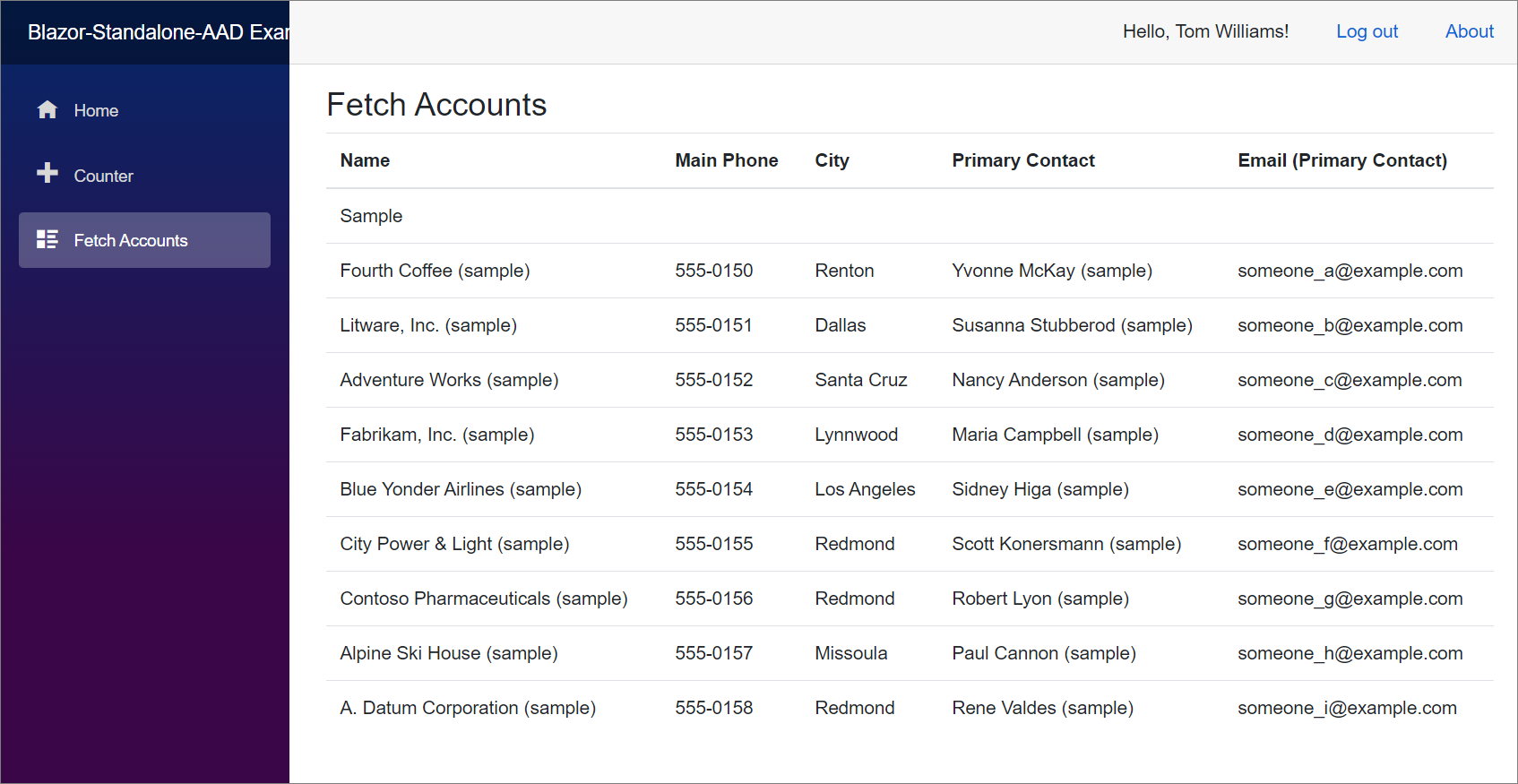
Prerequisites
To complete this tutorial, you must have:
- Access to a Dataverse environment with a database
- A Dataverse user with a security role that provides read access to the Account and Contact tables
- Understanding of the C# programming language
- Understanding of ASP.NET Core Blazor is helpful but not required
- The latest version of Visual Studio 2019 with the ASP.NET and web development workload installed.
Step 1: Verify prerequisites and information about the database
Let’s make sure that your environment is configured properly, and you understand where to perform the actions in Step 2.
Verify Dataverse database
-
Sign in to Power Apps.
-
Select Solutions in the navigation pane.

-
If you don’t see a list of installed solutions, use the environment selector at the top to choose a different environment that has a database. Otherwise create a new environment.
Get the Dataverse Web API URI
You will need the Instance Web API Service Root URL. This is found on the Developer Resources page of your Dataverse environment.
Follow the instructions found in View or download developer resources to copy the Url.
It will look something like this: https://yourorgname.api.crm.dynamics.com/api/data/v9.1/
Navigate to the Azure Active Directory portal
-
Sign in to Power Apps.
-
In the ‘waffle’ icon at the top left and select Admin.

-
This will take you to the Microsoft 365 admin center. In the left navigation, click Show all and select Azure Active Directory.

-
This will take you to the Azure Active Directory admin center. Expand the left navigation pane and select Azure Active Directory.
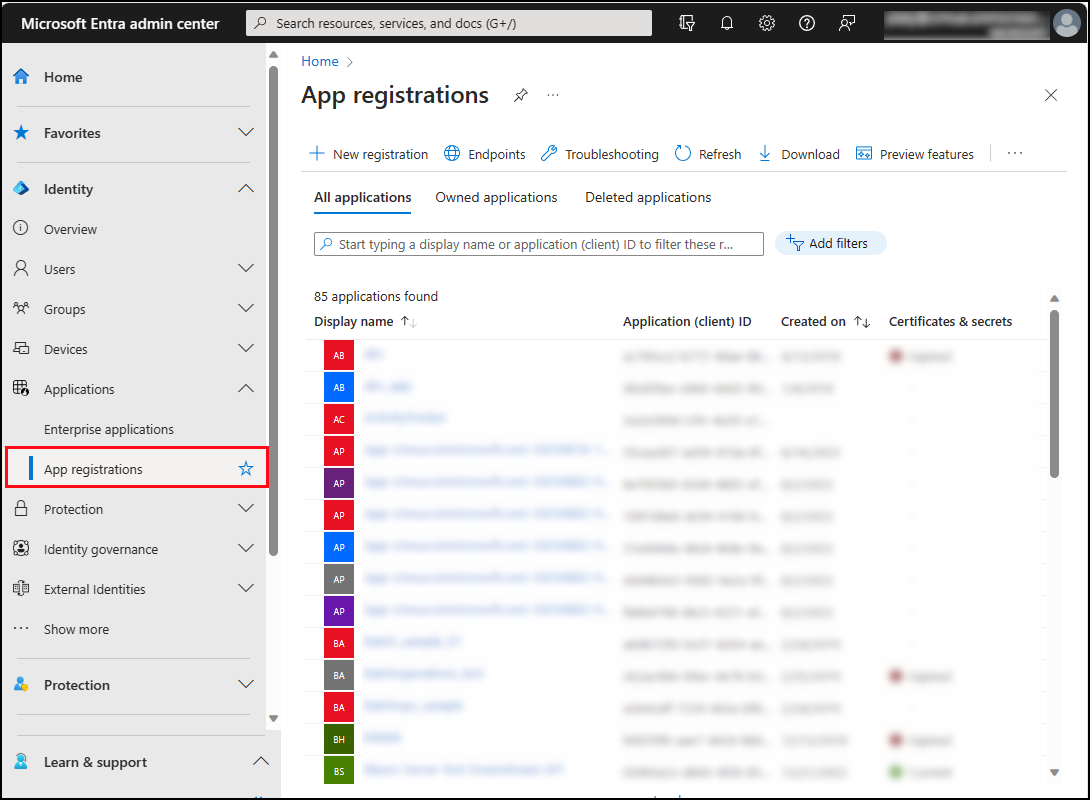
This takes you to the starting point for Step 2.
Step 2: Create a Blazor WebAssembly standalone app using Azure AD for authentication
The Secure an ASP.NET Core Blazor WebAssembly standalone app with Azure Active Directory topic provides a complete set of instructions to create the app.
These steps will describe how to create an app registration in Azure AD and run a .NET Core CLI command to generate the scaffold for the basic app with support for Azure AD authentication.
Note
At this time, you must use the .NET Core CLI command to generate the app. There is no template for this specific type of app when creating a project using Visual Studio.
Go to Secure an ASP.NET Core Blazor WebAssembly standalone app with Azure Active Directory and follow the instructions there to generate the basic app template.
Note
The rest of the content in this section provides supplemental information to assist in completing the steps described in the Secure an ASP.NET Core Blazor WebAssembly standalone app with Azure Active Directorytopic.
You may want to review this as you complete those steps, but it is not required. When you are done, come back here and start with Step 3 Grant API permissions.
Registering the application involves completing a form. The default value for the Redirect URI includes a placeholder for the port value. You must replace the placeholder with a number value to complete the registration, for example, just add 1111 for now. You can provide the randomly generated port value later after you open the project in Visual Studio. See Update callback URL.
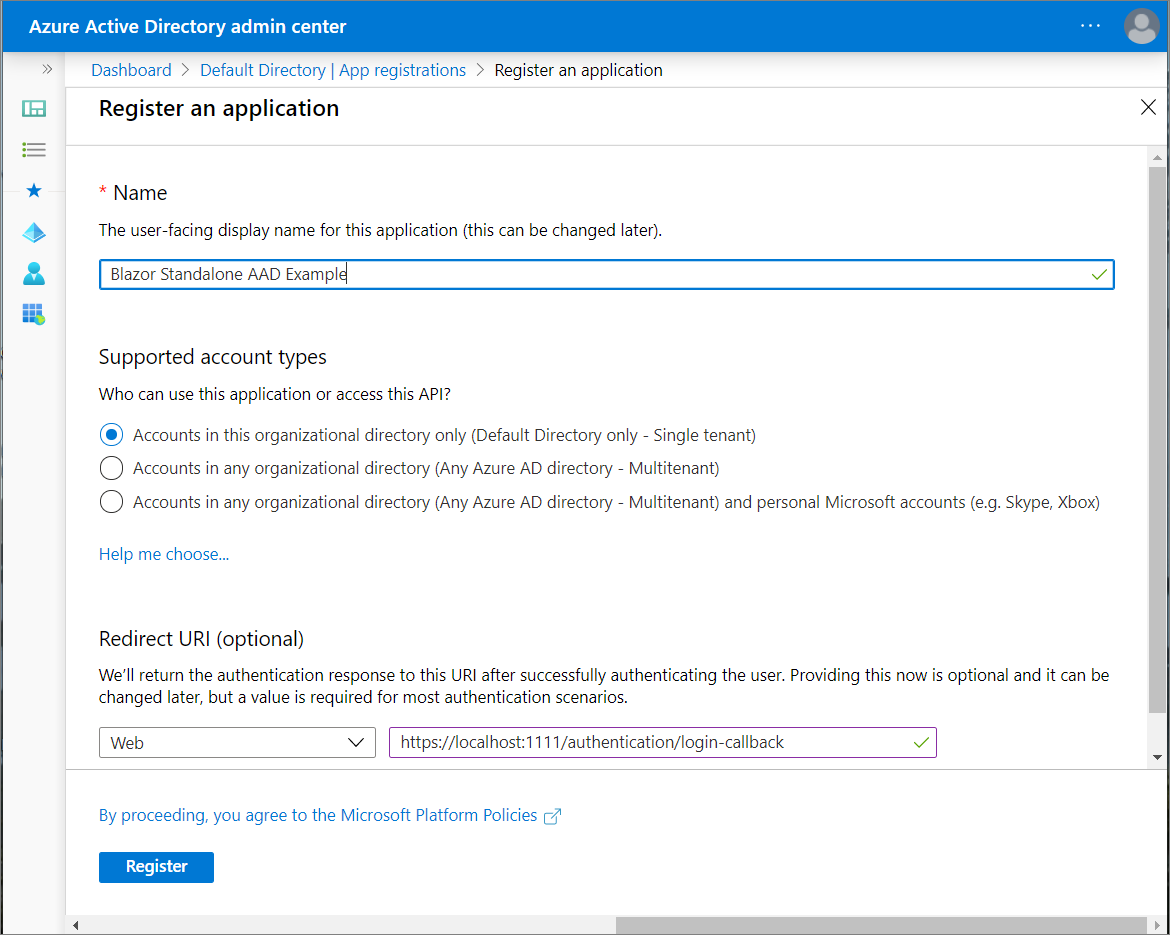
This will generate two ID values that you will need to include in the .NET Core CLI command. The following placeholders will be used in the content. You must use the values generated by the application registration process.
- The Application (Client) Id : Placeholder:
11111111-1111-1111-1111-111111111111 - Directory (Tenant) Id : Placeholder:
22222222-2222-2222-2222-222222222222
Important
Follow the instructions in the Secure an ASP.NET Core Blazor WebAssembly standalone app with Azure Active Directory topic to enable Access Tokens and ID tokens to enable the implicit grant and save your changes.
The .NET Core CLI command can be formatted this way and include a parameter to specify where the project should be created. You can run the command in an ordinary command window.
dotnet new blazorwasm^
-au SingleOrg^
--client-id "11111111-1111-1111-1111-111111111111"^
--tenant-id "22222222-2222-2222-2222-222222222222"^
-o "A:ProjectsBlazor-Standalone-AAD Example"
After you have run the command, navigate to the output folder and open the .csproj file using Visual Studio 2019.
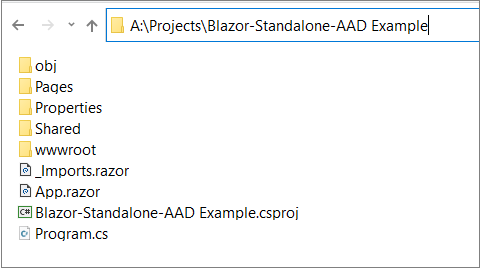
Within Visual Studio 2019 the project looks like this:
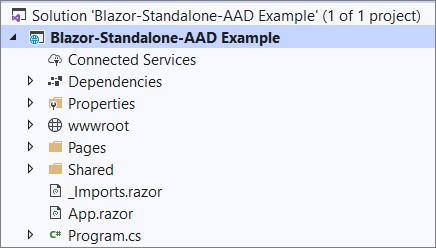
The rest of the Secure an ASP.NET Core Blazor WebAssembly standalone app with Azure Active Directory topic describes the components of the app template.
Update callback URL
The port setting used by Visual Studio is randomly generated. The callback URI in the application registration must be updated so that you can debug the app.
-
In Visual Studio, open the project properties and select Debug.
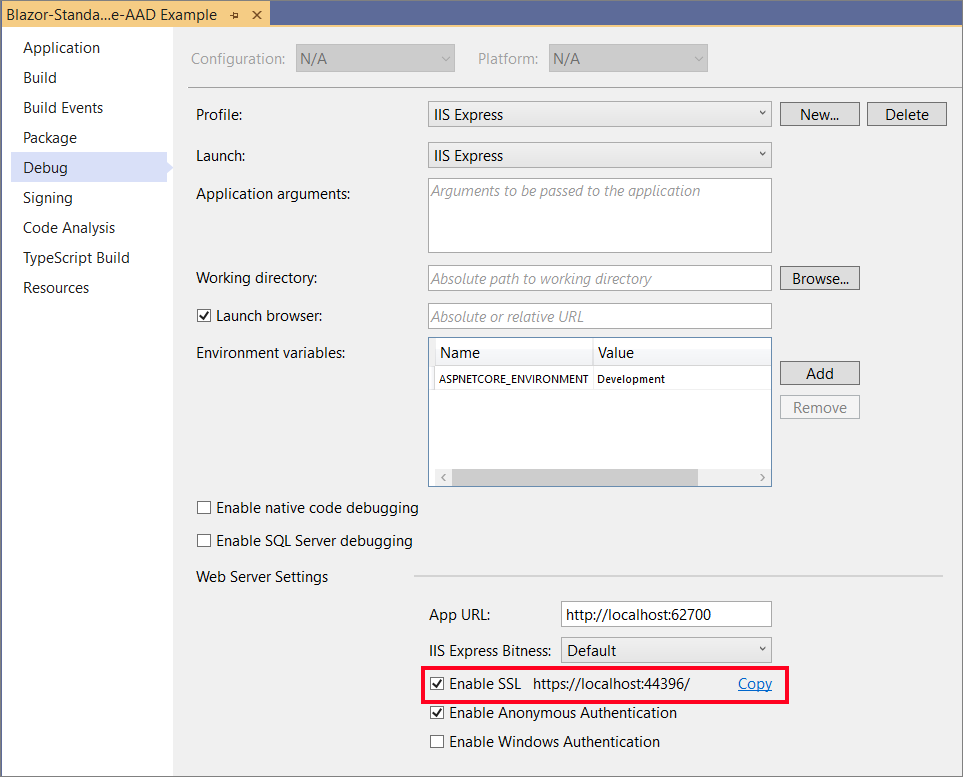
-
Under Web Server Settings copy the Enable SSL value that includes the random port assigned for debugging
-
Return to your app registration in Azure AD, In the Authentication section, change the Redirect URI to include this root Uri, then save your changes
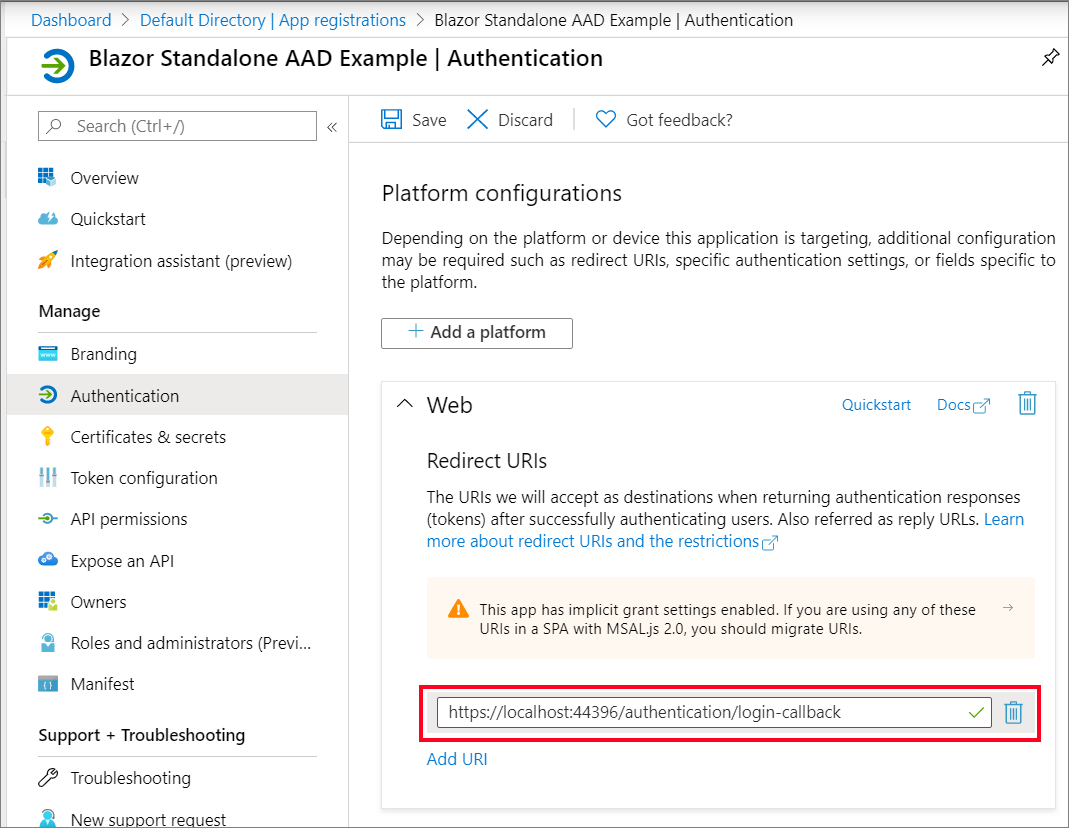
Verify that the app runs
Now that the Redirect URI has been updated; you should be able to press F5 in Visual Studio to run the app.
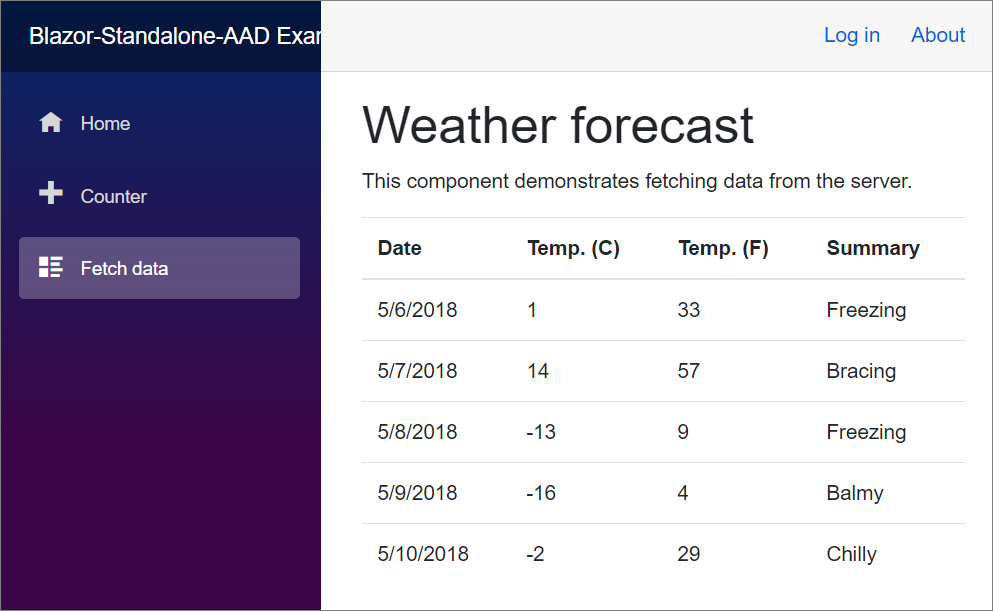
At this point, all the capabilities of the app work whether you log-in or not. Only members of the Azure AD tenant can log in.
Step 3: Grant API permissions
To connect to Dataverse, you must configure permissions for the app to connect.
-
Return to your app registration in Azure AD, In the API permissions section, click Add a permission.
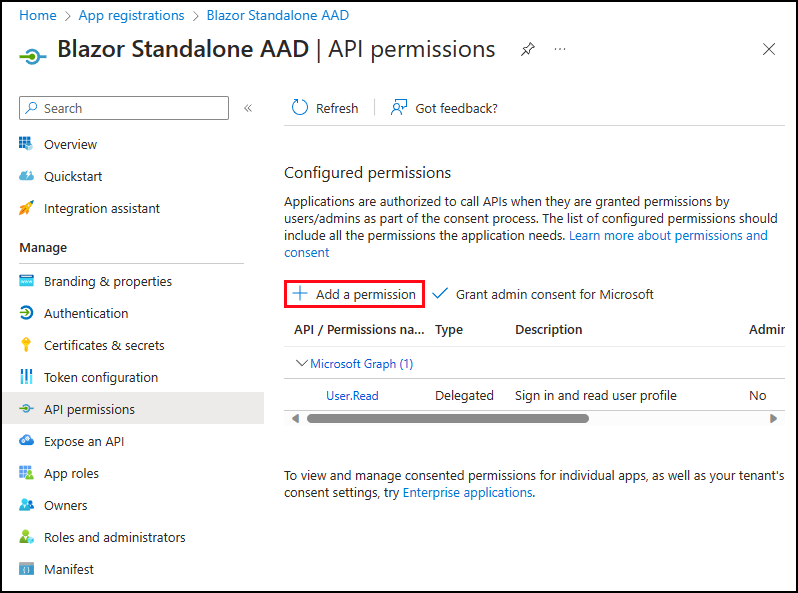
-
In the Request API permissions area, select APIs my organization uses and search for Common Data Service.
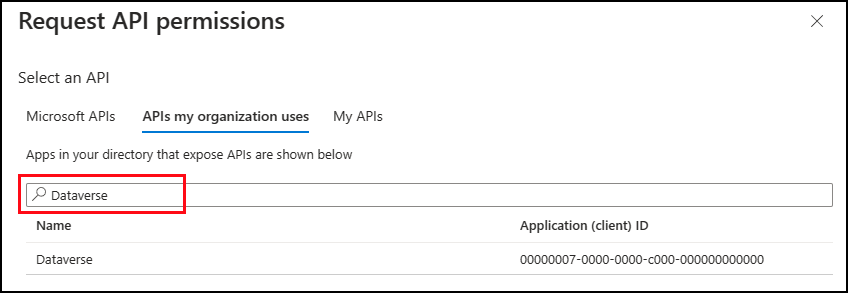
-
Select Common Data Service.
-
Select the user_impersonation permission
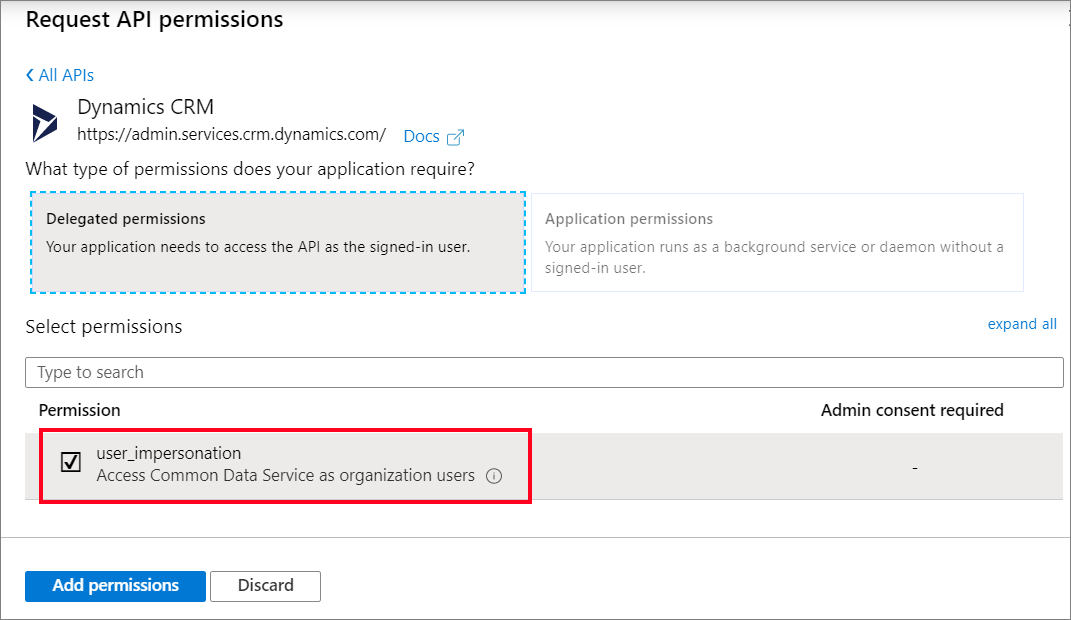
Note
Dynamics CRM and Dataverse refer to the same service.
-
Click Add permissions.
-
(Optional) For the Configured permissions, click Grant Admin consent for [Your Azure Active Directory tenant name]. In the screenshot below the tenant name is ‘Default Directory’. Yours may be different.

Step 4: Apply code changes
Apply changes to the following files to enable displaying Dataverse data in the application.
wwwrootappsettings.json
You will find that this file already has configuration information generated by the template with information about the application registered in Azure AD. It will look like this:
{
"AzureAd": {
"Authority": "https://login.microsoftonline.com/22222222-2222-2222-2222-222222222222",
"ClientId": "11111111-1111-1111-1111-111111111111",
"ValidateAuthority": true
}
}
Update the file to include a new CDSWebAPI section that includes the root of the Instance Web API Service Root URL you copied in the Get the Dataverse Web API URI step.
Note
You don’t need the full URL, just the root.
{
"AzureAd": {
"Authority": "https://login.microsoftonline.com/22222222-2222-2222-2222-222222222222",
"ClientId": "11111111-1111-1111-1111-111111111111",
"ValidateAuthority": true
},
"CDSWebAPI": {
"ResourceUrl": "https://yourorg.api.crm.dynamics.com",
"Version": "v9.1",
"TimeoutSeconds": 30
}
}
Program.cs
-
Install the
Microsoft.Extensions.HttpNuGet package.- In the solution explorer, right-click the project and select Manage NuGet Packages....
- Select Browse and search for
Microsoft.Extensions.Http. - Install the latest version of the package.

-
Add the following code below the line that starts with
builder.Services.AddTransient(sp => new HttpClient...C#// Get configuration data about the Web API set in wwwroot/appsettings.json var CDSWebApiConfig = builder.Configuration.GetSection("CDSWebAPI"); var resourceUrl = CDSWebApiConfig.GetSection("ResourceUrl").Value; var version = CDSWebApiConfig.GetSection("Version").Value; var timeoutSeconds = int.Parse(CDSWebApiConfig.GetSection("TimeoutSeconds").Value); // Create an named definition of an HttpClient that can be created in a component page builder.Services.AddHttpClient("CDSClient", client => { // See https://docs.microsoft.com/powerapps/developer/data-platform/webapi/compose-http-requests-handle-errors client.BaseAddress = new Uri($"{resourceUrl}/api/data/{version}/"); client.Timeout = TimeSpan.FromSeconds(timeoutSeconds); client.DefaultRequestHeaders.Add("OData-Version", "4.0"); client.DefaultRequestHeaders.Add("OData-MaxVersion", "4.0"); }); -
Add the following code below the line that starts with
builder.Configuration.Bind("AzureAd" ...C#// Add access to Dataverse to the scope of the access token when the user signs in options.ProviderOptions.DefaultAccessTokenScopes.Add($"{resourceUrl}/user_impersonation");
Add PagesFetchAccounts.razor
This is a new page that will display the account information.
-
In solution explorer, right click Pages and select Add > Razor Component… from the context menu and name it
FetchAccounts.razor. -
Replace the code in the file with the following:
CSHTML@page "/fetchaccounts" @using Microsoft.AspNetCore.Components.WebAssembly.Authentication @using System.Net.Http.Headers @using System.Net.Http.Json @using Microsoft.Extensions.Logging; @using System.Text.Json.Serialization; @inject IAccessTokenProvider TokenProvider @inject IHttpClientFactory ClientFactory @inject ILogger<FetchAccounts> logger; <AuthorizeView> @*Only show the list if the user is signed in and authorized*@ <Authorized> <h3>Fetch Accounts</h3> @if (accounts != null) { <table class="table"> <thead> <tr> <th>Name</th> <th>Main Phone</th> <th>City</th> <th>Primary Contact</th> <th>Email (Primary Contact)</th> </tr> </thead> <tbody> @foreach (Account account in accounts.value) { <tr id="@account.accountid"> <td> @((account.name != null) ? account.name : string.Empty) </td> <td> @((account.telephone1 != null) ? account.telephone1 : string.Empty) </td> <td> @((account.address1_city != null) ? account.address1_city : string.Empty) </td> <td> @((account.primarycontactid != null) ? (account.primarycontactid.fullname != null ? account.primarycontactid.fullname : string.Empty) : string.Empty) </td> <td> @((account.primarycontactid != null) ? (account.primarycontactid.emailaddress1 !=null ? account.primarycontactid.emailaddress1 : string.Empty) : string.Empty) </td> </tr> } </tbody> </table> } else { <p><em>@message</em></p> } </Authorized> <NotAuthorized> <h3>Authentication Failure!</h3> <p>You're not signed in.</p> </NotAuthorized> </AuthorizeView> @code { //The collection of Account records to display private AccountCollection accounts; //An informational message private string message = "Loading..."; //Contains data about an error returned from the Web API private Error error; // Method invoked when the component is ready to start, having received its initial parameters from its parent in the render tree. // Override this method if you will perform an asynchronous operation and want the component to refresh when that operation is completed. protected override async Task OnInitializedAsync() { // Tries to get an access token for the current user with the default set of permissions. var tokenResult = await TokenProvider.RequestAccessToken(); // If the token request was successful if (tokenResult.TryGetToken(out var token)) { //Creates an HttpClient based on the named definition found in Program.Main var client = ClientFactory.CreateClient("CDSClient"); //Prepare the request to get the data var request = new HttpRequestMessage() { Method = HttpMethod.Get, RequestUri = new Uri($"{client.BaseAddress}accounts?" + "$select=name,telephone1,address1_city&" + "$expand=primarycontactid($select=fullname,emailaddress1)") }; //Add the access token request.Headers.Authorization = new AuthenticationHeaderValue("Bearer", token.Value); //Specify a JSON result is expected request.Headers.Accept.Add(new MediaTypeWithQualityHeaderValue("application/json")); //Limit the number of results to 10 request.Headers.Add("Prefer", "odata.maxpagesize=10"); //Send the request var response = await client.SendAsync(request); if (response.IsSuccessStatusCode) { //Parse the JSON returned into a strongly typed AccountCollection accounts = await response.Content.ReadFromJsonAsync<AccountCollection>(); } else { //Parse the JSON returned into a strongly typed Error error = await response.Content.ReadFromJsonAsync<Error>(); error.statuscode = (int)response.StatusCode; error.reason = response.ReasonPhrase; //Display a message to the user message =